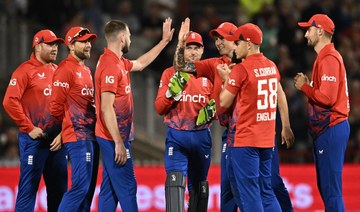EGYPT: On a desert track in eastern Egypt camels race across the sand, urged on by their young jockeys and a convoy of cars speeding alongside them.
The race is part of an annual camel festival outside the city of Ismailia which has attracted participants from 13 Arab countries this year, as well as enthusiasts from France, Germany, Italy and Austria.
While the prize money is modest — 100,000 Egyptian pounds ($5,500) split between the winners of several races — competition among bedouin tribes is strong.
Organizers hope international interest is growing, pointing to the presence this year of Europeans who came to see how the festival was organized, though they did not take part in the races.
“It’s the first time they have come,” said Sheikh Suleiman Abu Shukri, whose tribe extends from Egypt’s Sinai peninsula into neighboring Saudi Arabia.
Around 150 camels competed in races ranging from the relatively short 3 km (2 mile) course to a 15 km race, or three laps of the 5 km circuit. The jockeys were mostly small children aged 11 or under. ($1 = 18.2500 Egyptian pounds)
Egypt camel racers hope desert sport will spread to fresh pastures
Egypt camel racers hope desert sport will spread to fresh pastures

Saudi national football team prepares for Asian qualifiers

- Players participating in the King’s Cup final between Al-Nasser and Al-Hilal on Friday will join the national squad on Sunday
- Green Falcons fly to Islamabad on Wednesday for their game against Pakistan on Thursday, and then host Jordan in Riyadh on June 11
RIYADH: The Saudi national football team gathered at their training camp in Riyadh on Thursday to begin preparations for the upcoming Asian qualifiers for the 2026 World Cup and the 2027 Asian Cup.
As the Green Falcons held their first training session on Thursday evening behind closed doors at Mahd Academy, members of the squad from Al-Nasser and Al-Hilal, who will meet in the final of the King’s Cup on Friday, were absent. They will join the national team’s preparations on Sunday after head coach Roberto Mancini gave them a day off on Saturday to recover.
The 31-player squad, announced by Mancini last week, will fly out on Wednesday for their game against Pakistan in Islamabad on June 6, and then host Jordan at Alwal park in Riyadh on June 11.
Saudi Arabia currently tops Group G of the Asian qualifiers, with 10 points from four games, ahead of Jordan (7 points) and Tajikistan (5). Pakistan are bottom of the group having lost all four games so far.
Cricket’s ability to mock itself

- Shorter forms of cricket started as “a bit of a joke” but are now behemoths threatening longer-established formats
LONDON: In cricket, what started out as a “bit of a laugh” but turned out to be much more serious? This is not a trick question. It could refer to Test cricket’s origins. England v Australia, five-day matches, players switching allegiance between countries, a jibe by Australians to create the “ashes” of English cricket in an urn. Although this turned a bit of fun into a deadly serious contest over almost 150 years, it is not the answer.
Another possibility is the start of limited-overs cricket. The first so-called international limited-overs match was played between Australia and England on Jan. 5, 1971 in Melbourne. The first three days of a Test match had been rained off and the authorities faced a significant loss of income. They decided to abandon the match, replace it with a one-off, one-day match and add a seventh Test at the end of the series. This was much to the surprise and reluctance of the players, who were not consulted.
The English players seemed more concerned about receiving money for being asked to play extra matches. They were used to the benefits of limited-over cricket, which had started in the English and Welsh professional game in 1963 as a response to falling attendances and defensive play. Although commercially successful, with a sponsor in Gillette, no other Test-playing nation displayed any enthusiasm for the format. The decision by the Australian authorities to stage the match did not raise a laugh among the players, while the Australian Cricket Board was not laughing in the face of a serious need to generate income.
On what would have been day five of the Test match, the one-day game went ahead in a format of 40 overs, each of eight deliveries, the standard in Australia at the time. The teams were billed as an “England XI” and an “Australia XI.” Press reports referred to it as a “one-day Test match.” Any skepticism about the match by players and authorities was not shared by spectators, 46,000 of them turning up to watch.
This was a light-bulb moment for the Australian Cricket Board, whose head, Sir Donald Bradman, proclaimed: “You have seen history made.” Australia won the match, the England captain admitting that his players did not take the game seriously, although they were relieved to play some cricket after having spent so much time in the dressing room, as well as receiving an extra £50 for participating.
In this rather grumpy and fragile set of circumstances history was, indeed, created without many of the participants recognizing the significance of the event. Some years later, one Australian player recalled his surprise that a game they thought a “bit of a joke” became part of cricket’s history.
A revolution had been set in train. In 1973, the first women’s one-day world cup was staged, followed by the men’s in 1975. Kerry Packer’s breakaway World Series Cricket in 1977 in Australia shook cricket’s authorities into realizing the commercial opportunities offered by the format. At that time, Australia, England and the West Indies were dominant. India did not take the format, often referred to as “pyjama cricket” because of the use of colored kit, at all seriously.
This all changed in 1983 when not only did India take the format seriously but its team also won the one-day world cup, defeating England, Australia and the West Indies along the way, inspired by the captain, Kapil Dev. In two months, the appeal of limited-overs cricket was transformed, as the Indian public fell head-over-heels in love with it and its heroes. Triangular and quadrangular tournaments were spawned on the Indian subcontinent and Sharjah. A joke became a joyful and serious commercial activity.
Yet, this is still not the answer to the original question. At the turn of the 20th century, falling attendances in England and Wales, poor performances by the national team and the imminent banning of tobacco advertising in sport combined to create a new crisis. Based on focus groups and surveys, the England and Wales Cricket Board concluded that the population wanted a form of cricket with wider appeal in terms of both duration and form of delivery. Reduced-over formats, such as 15 eight-ball or 20 overs of six balls, had been used for decades in club cricket in mid-week evening cups. In 2002, the board proposed a new Twenty20 Cup competition for the professional game.
This was narrowly approved by the county cricket clubs and launched in May 2003 on a roof garden in central London with members of a quickly forgotten pop group appearing in a tacky photoshoot. They were accompanied by the captains of the two county teams that were to contest the first match. One of them admitted to cringing when he saw the result of the photoshoot. He also said that he found the first match, on June 13, 2003, a “bit of fun.” It was not taken too seriously, as the general view was that it would not last.
How wrong could they have been? Another piece of cricketing history had been made, without anyone understanding the significance of the event. Counties used increasingly garish methods to entertain their new breed of spectators, who responded positively, thus ensuring that the format lasted longer than many thought would be the case. Once again, India was slow to adopt the format, but when it did cricket was transformed, the subcontinent effectively hijacking the new format.
The impacts of this continue to reverberate and encroach on other formats, as well as driving the game’s global expansion. Matches in the imminent twenty-team T20 World Cup will take place in the US, and T20 cricket will be an Olympic sport in 2028. So, from being a “a bit of a laugh,” it has become the dominant format and a commercial behemoth of existential threat to longer-established formats, both of which started as a “bit of a joke.” Cricket has a way of making fools of those who joke.
Saudi boxer Ziyad Al-Maayouf: Pioneering a new era in the sport

- In Ziyad Al-Maayouf, boxing has found not just a competitor, but a pioneer
- “Hopefully very soon we’ll be bringing a belt back to Saudi.”
Riyadh: In the heart of the boxing world, where legends are made and dreams are realized, a new figure is emerging, one that embodies the fusion of tradition and innovation, heritage and progress. Ziyad Al-Maayouf, a Saudi boxer with a vision as expansive as the desert horizon, is not just stepping into the ring; he is stepping into history.
“I’m honestly just looking at it right now. And I’m looking forward to being ringside and just, you know, living the dreams of a Saudi boxer, first. But, you know, just someone who loves the sport, second,” Al-Maayouf said.
His ascent is not merely about personal glory; it is also about rewriting the narrative of boxing itself. “Hopefully very soon we’ll be bringing a belt back to Saudi,” he added, his determination palpable. “I’m not going to stop until I do that.”
For Al-Maayouf, every fight is a testament to the golden era of boxing he finds himself in. “Like I always say, this is what I would like to call the golden era of boxing,” he said, adding that the spirit of the age continues to “inspire young fighters like me to take risks, fight the best.
“The records don’t matter. You know, bring out the real fighter in you and bring out the good fights.”
As Al-Maayouf prepares for his next bout, he carries with him the hopes and dreams of a nation, the aspirations of a global audience, and the unwavering belief that in the squared circle, anything is possible. “We want to see the sport of boxing go back to the top five and maybe even the top one sport of the world.”
In Ziyad Al-Maayouf, boxing has found not just a competitor, but a pioneer — a man whose journey transcends borders, whose dreams inspire generations and whose fists carry the weight of history. As he steps into the ring, he does so not just as a fighter, but as a symbol of what boxing was, what it is, and what it can become.
Maradona’s heirs lose court battle to block auction of World Cup Golden Ball trophy

- Maradona’s heirs tried to stop the auction of the Golden Ball trophy he received for being the best player of the 1986 World Cup
- Lawyer Gilles Moreu told The AP the court’s ruling “was not favorable to the heirs of Diego Maradona” and said he would lodge an appeal
PARIS: A French court ruled the auction of a trophy awarded to the late Diego Maradona after the 1986 World Cup can go ahead as planned despite opposition from his heirs, their lawyer told The Associated Press on Thursday.
Maradona’s heirs tried to stop the auction of the Golden Ball trophy he received for being the best player of the 1986 World Cup by starting an urgent judicial procedure. Lawyer Gilles Moreu told The AP the court’s ruling “was not favorable to the heirs of Diego Maradona” and said he would lodge an appeal.
The trophy is set to be auctioned next Thursday in Paris by the Aguttes auction house, which did not immediately comment on the ruling.
The Golden Ball was missing for decades after it disappeared in uncertain circumstances and only recently resurfaced. Maradona’s heirs say the trophy was stolen and claimed the current owner wasn’t entitled to sell it. Aguttes said the trophy reappeared in 2016 among other lots that were acquired from a private collection at auction in Paris.
Moreu said the president of the Nanterre court outside Paris considered the current owner of the trophy, identified as Mr. Benchaieb, “should be considered as acting in good faith.”
Benchaieb and Aguttes claimed that when he bought the trophy years ago he was not aware it had been stolen.
“The Ballon d’Or is a unique piece of property, which Diego Maradona’s children want back,” Moreu said. “My clients are extremely saddened by the court’s decision.”
Maradona received the award in 1986 at a ceremony at the Lido cabaret on the Champs-Élysées. It subsequently disappeared, giving rise to rumors. Some say it was lost during a poker game or sold to pay off debts. Others say Maradona stored it in a safe in a Naples bank that was robbed by local gangsters in 1989 when he played in the Italian league. Maradona’s heirs believe it was stolen from the bank.
French judicial officials last week opened an investigation after they received a complaint relating to the resale of allegedly stolen goods. The Nanterre prosecutor’s office did not say whether the court’s decision would have an impact on the probe, and if it was still ongoing.
Maradona, who died in 2020 at age 60, captained Argentina in its 3-2 win over West Germany in the 1986 final in Mexico City. In a quarterfinal win over England he scored the “Hand of God” goal and the “Goal of the Century.”
Aguttes said it expects the trophy “to fetch millions due to its uniqueness.”
Bidders will be asked to make a deposit of 150,000 euros ($161,000) to participate in the auction.
The Hand of God goal came when Maradona punched the ball into England’s net. Four minutes later, he weaved through England’s midfield and defense and past goalkeeper Peter Shilton for what FIFA later declared the greatest goal in World Cup history.
Kompany to stick with same footballing principles after swapping Burnley for Bayern Muncih

- “At this club and this journey, I have no intention of being a different person,” Kompany said
- Kompany said the fact that next season’s Champions League final is being staged at Munich’s Allianz Arena will be used as some motivation
MUNICH: Vincent Kompany insists his footballing principles will not change after swapping the Championship for the Champions League by making the unlikely move from Burnley to Bayern Munich.
Kompany led Burnley to promotion to the Premier League in his first season at the northwest English club, only to get a reality check when his bold and attacking style of play was exposed in the top division.
Burnley’s relegation led to accusations by some that Kompany’s tactics were naïve, but the former Manchester City and Belgium defender said he was proud to have stayed consistent “in the very highs and the very lows” and will be working the same way at Bayern.
“At this club and this journey, I have no intention of being a different person,” Kompany said on Thursday at a news conference where he was presented as the replacement for Thomas Tuchel. “I don’t think that’s what they want.”
Kompany will, therefore, ask the same things from Bayern’s higher-quality players as he did from those at Burnley.
“I want the players of Bayern Munich to be brave, really brave on the ball, to have personality on the ball,” he said. “But also my nature is, I’m also someone that is aggressive, so I want the team to be aggressive.
“I want the team to represent those two things that would make my character — absolutely brave when they have the ball, when they’re making decisions, and absolutely aggressive, something that they carry throughout every minute of the game always.”
Kompany said the fact that next season’s Champions League final is being staged at Munich’s Allianz Arena will be used as some motivation.
“The goal is for me quite simple: I always try to win every match. It doesn’t matter where you are, it is always most, most important that we want to win every match,” he said. “That the Champions League final is here in Munich might make it a bit more important than the others, if I am honest. But I know we will not reach it by just expressing it.”






























